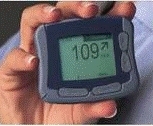by
Joan Trombetti, Writer | September 19, 2007

Sensors and pumps may
create artificial pancreas.
A new sensor to help diabetes better track their glucose levels has been approved by Federal health officials. The children's version of the sensor works for three days in a row, and a long lasting 7-day version has been approved for adults.
This new sensor is just a beginning toward an ultimate goal to create "an artificial pancreas" by pairing sensors with implanted pumps that would automatically dispense insulin to make blood sugar better resemble a healthy person. A feature of the sensors is an alarm that sounds when blood-sugar levels are dangerously high or low.
How It Works




Ad Statistics
Times Displayed: 45408
Times Visited: 1421 Keep biomedical devices ready to go, so care teams can be ready to care for patients. GE HealthCare’s ReadySee™ helps overcome frustrations due to lack of network and device visibility, manual troubleshooting, and downtime.
Some 21 million Americans have diabetes, a disease that does not allow the body to properly regulate blood sugar or glucose. About 5 million diabetics inject insulin, a hormone that converts glucose into energy, to treat their diabetes - including approximately 2 million with Type 1 diabetes who require those shots to live. Blood vessels and nerves are damaged from high glucose levels, which can lead to kidney failure, amputations and heart disease, as well as blindness. It is imperative for diabetics to frequently test glucose levels. Until recently, this was done by pricking a finger for a blood test four to eight times a day; thus, helping patients maintain control over glucose levels and lowering the risk of the above complications.
Unfortunately, most diabetics forget or simply do not test that often and do not know whether or not their glucose has fallen or risen between the tests they do perform or while sleeping. Using a sensor, diabetics will insert a needle under the skin of the side or abdomen every three or seven days. The sensor will then beam glucose readings to a pager-like device every 5 minutes.

